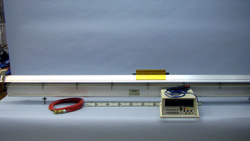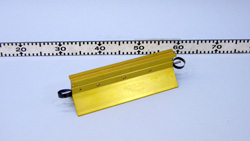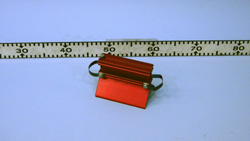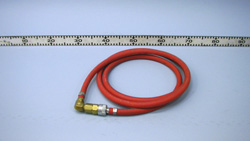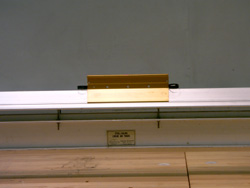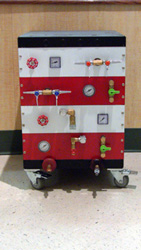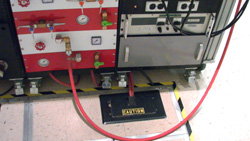|
Size: 1562
Comment:
|
← Revision 12 as of 2018-07-18 16:38:58 ⇥
Size: 3157
Comment:
|
| Deletions are marked like this. | Additions are marked like this. |
| Line 1: | Line 1: |
| ## page was renamed from Persistence of Motion (air track) | |
| Line 2: | Line 3: |
| ||<:30%>[:PiraScheme#Mechanics: Table of Mechanics Demonstration]||<:30%>[:MEEquipmentList: List of Mechanics Equipment & Supplies]||<:30%>[:Demonstrations:Lecture Demonstrations]|| | ||<30% style="text-align:center">[[PiraScheme#Mechanics|Table of Mechanics Demonstration]] ||<30% style="text-align:center">[[MEEquipmentList|List of Mechanics Equipment & Supplies]] ||<30% style="text-align:center">[[Demonstrations|Lecture Demonstrations]] || |
| Line 4: | Line 5: |
| = Persistence of Motion (air track), 1F30.10 = | |
| Line 6: | Line 6: |
| = Persistence of Motion (Air Track), 1F30.10 = | |
| Line 7: | Line 8: |
| Newton's First Law, [:Newtons1STLaw#InertiaofMotion: 1F30. Inertia of Motion] | . Newton's First Law, [[Newtons1STLaw#InertiaofMotion|1F30. Inertia of Motion]] '''pira200 Listed''' |
| Line 10: | Line 14: |
| * '''Cabinet:''' [:MechanicsCabinet:Mechanic (ME)] * '''Bay:''' [:MechanicsCabinetBayA1:(A1)] * '''Shelf:''' #1 |
|
| Line 14: | Line 15: |
| (attachment photo showing the fully set up demonstration) | * Floor Item: ME, South Wall on shelf brackets {{attachment:AirTrackSetup21-400.jpg}} |
| Line 18: | Line 21: |
| A cart is pushed on a low-friction air track and thus given a velocity which remains roughly constant as per Newton's first law. ||<:style="width: 60%" :40%>'''Equipment'''||<:30%>'''Location'''||<:25%>'''ID Number'''|| |
A cart on a low-friction air track is given a velocity which remains roughly constant as per Newton's first law. ||<40% style="" ;text-align:center">'''Equipment''' ||<30% style="text-align:center">'''Location''' ||<25% style="text-align:center">'''ID Number''' || |
| Line 22: | Line 24: |
| ||apparatus||ME, Bay B1, Shelf #2|| || ||all other parts||ME, Bay B1, Shelf #2|| || ||...||ME, Bay B1, Shelf #2|| || '''''Important Setup Notes:''''' * N/A |
||2.25m Air Track ||ME, South Wall on shelf brackets || || ||A Glider ||ME, Bay A4, Shelf #2 || || ||Air Hose ||ME, South Wall on shelf brackets || || ||[[RedWhiteGasCart|Air Supply]] ||Located rooms 2103, 2241, and 2223 ||4A.EQ100 || |
| Line 30: | Line 30: |
| '''Setup and Procedure:''' | |
| Line 32: | Line 31: |
| 1. Make a Setup check list. 1. ... |
'''''Important Setup Notes:''''' * '''''This demonstration requires a supply of compressed air at HVHP.''''' * '''''A [[RedWhiteGasCart|Red & White Gas Cart]] will need to be installed under the lecture tables and the air hose will need to be connected to the supply line within the stage floor.''''' '''Setup and Procedure:''' 1. Place air track on lecture bench. 1. Level the track using the set screws on each leg. 1. Connect the track to the air supply using the air hose. 1. Place air glider on track. 1. Let the air flow into the track by opening the supply valve. 1. Give the air glider a push to give it an initial velocity. |
| Line 36: | Line 47: |
| Line 38: | Line 50: |
| '''Discussion:''' | |
| Line 39: | Line 52: |
| '''Discussion:''' | The kinematic version of Newton's first law says that a body in motion tends to stay in motion moving in a straight line unless acted upon by a force. This is exactly what is happening here. The glider is given an initial velocity being accelerated by the lecturer's hand. Upon release, the glider maintains its final velocity. The air track provides a low-friction surface for the glider to move on so not much energy can be lost as heat. Thus the speed will remain roughly constant. The direction will change, however. The velocity will switch between '''v,,0,,''' and -'''v,,0,,''' each time it hits a bumper in an elastic collision whereby the direction of its momentum is reversed. || {{attachment:AirTrack01-250.jpg}} || {{attachment:LargeGlider-250.jpg}} || {{attachment:SmallGlider-250.jpg}} || {{attachment:AirHose-250.jpg}} || || {{attachment:AirTrackSetup28-250.jpg}} || {{attachment:AirCompressor02-250.jpg}} || {{attachment:AirCompressor15-250.jpg}} || |
| Line 41: | Line 56: |
| Insert description of demonstration, how is the demonstration preformed. | |
| Line 43: | Line 57: |
| ||attachment other photos||attachment other photos||attachment other photos||attachment other photos|| | |
| Line 46: | Line 60: |
| * [https://www.youtube.com/user/LectureDemostrations/videos?view=1 Lecture Demonstration's Youtube Channel] | * [[https://www.youtube.com/user/LectureDemostrations/videos?view=1|Lecture Demonstration's Youtube Channel]] |
| Line 52: | Line 67: |
[:Instructional:Home] |
[[Instructional|Home]] |
Persistence of Motion (Air Track), 1F30.10
Topic and Concept:
Newton's First Law, 1F30. Inertia of Motion
pira200 Listed
Location:
- Floor Item: ME, South Wall on shelf brackets
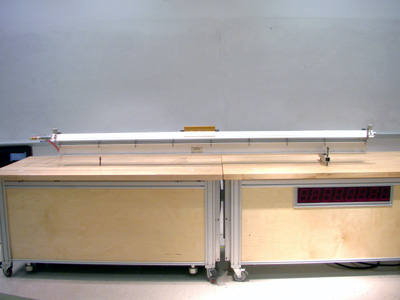
Abstract:
A cart on a low-friction air track is given a velocity which remains roughly constant as per Newton's first law.
Equipment |
Location |
ID Number |
|
|
|
2.25m Air Track |
ME, South Wall on shelf brackets |
|
A Glider |
ME, Bay A4, Shelf #2 |
|
Air Hose |
ME, South Wall on shelf brackets |
|
Located rooms 2103, 2241, and 2223 |
4A.EQ100 |
Important Setup Notes:
This demonstration requires a supply of compressed air at HVHP.
A Red & White Gas Cart will need to be installed under the lecture tables and the air hose will need to be connected to the supply line within the stage floor.
Setup and Procedure:
- Place air track on lecture bench.
- Level the track using the set screws on each leg.
- Connect the track to the air supply using the air hose.
- Place air glider on track.
- Let the air flow into the track by opening the supply valve.
- Give the air glider a push to give it an initial velocity.
Cautions, Warnings, or Safety Concerns:
- N/A
Discussion:
The kinematic version of Newton's first law says that a body in motion tends to stay in motion moving in a straight line unless acted upon by a force. This is exactly what is happening here. The glider is given an initial velocity being accelerated by the lecturer's hand. Upon release, the glider maintains its final velocity. The air track provides a low-friction surface for the glider to move on so not much energy can be lost as heat. Thus the speed will remain roughly constant. The direction will change, however. The velocity will switch between v0 and -v0 each time it hits a bumper in an elastic collision whereby the direction of its momentum is reversed.
|
|
|
|
|
|
|
Videos:
References:
- N/A
